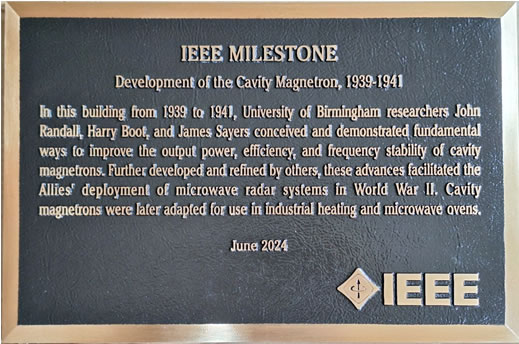IEEE Milestone Award Event | Development of the Cavity Magnetron, 1939-1941
On the 4th of June 2024, there will be an IEEE Historical plaque unveiling event to celebrate the development of the cavity magnetron by J Randall & H Boot & J Sawers at University of Birmingham in 1939.
Background
In 1939, at the start of the war, there was a need to efficiently achieve higher power microwave energy to enable the advance from land based into airborne radar. John Randall and Harry Boot at Birmingham produced, in 1940, their first working magnetron incorporating their novel resonant cavity design, which enabled the generation of hundreds of Watts of power at 10 cm wavelength.
Subsequently the engineers at the General Electric Company (GEC) in Wembley, re-engineered this device for mass production, enabling it to generate well over a kilowatt of pulsed power. These high-power microwave pulses could then be transmitted from an antenna only centimetres long, reducing the size of practical radar systems and improving the resolution of targets. This enabled the realisation of British and American long-range night-fighter and anti-submarine airborne radar systems.

This event celebrates these technical advances with the unveiling of an IEEE Historical plaque at the University of Birmingham.
Milestone Event
The event will consist of a morning ceremony unveiling the plaque, followed by an afternoon technical symposium.
10:00 – 10:05 – Coffee along with display of historical artifacts
11:00 – 11:05 – Welcome by the UoB, Prof Adam Tickell, Vice Chancellor, University of Birmingham
11:05 – 11:10 – The IEEE and the importance of preserving the history of Electrical Engineering, Dr Thomas Coughlin, IEEE President
11:05 – 11:10 – The IEEE Foundation and its support for the History Centre, Prof Sarah Spurgeon, UCL and IEEE Foundation
11:10 – 11:15 – The IEEE Milestone Program, Prof David Michelson, Chair, IEEE History Committee
11:15 – 11:20 – This milestone on the generation of high-power microwave energy, Prof Peter Grant, University of Edinburgh
11:20 – 11:25 – The International importance of these developments, Dr Tim Hall, MIT Lincoln Laboratory
11:25 – 11:40 – Unveiling of the Milestone plaque, Prof Adam Tickell Vice Chancellor, University of Birmingham and Dr Thomas Coughlin, IEEE President
11:40 – 12:00 – Closure of the session, Rod Muttram, IEEE UK&I Industry liaison and Life members Affinity Group
12:00 – 13:00 – Buffet lunch
13:00 – Welcome and Introduction, Prof Charles Turner, Former IEEE UK & Ireland Section Chair
13:00 – 13:30 – Early Radar Developments up to 1939, Prof Hugh Griffiths, University College London
13:30 – 14:00 – The British Development of the Cavity Magnetron, Prof Peter Grant, University of Edinburgh
14:00 – 14:30 – American Airborne Radar Development at the MIT Radiation Laboratory, Dr Mohamed Abouzhara, MIT Lincoln Laboratory
14:30 – 14:45 – Canadian Microwave Radar Projects in WW2, Prof David Michelson, University of British Columbia
14:45 – 15:00 – Break
15:00 – 15:30 – British Airborne Radar Development in WW2, Prof Simon Watts, University College London
15:30 – 16:00 – From the Cavity Magnetron to Multi-function RF systems, Dr Iain Scott, Leonardo
16:00 – 16:30 – Current Birmingham Radar and Microwave Research, Prof Marco Martorella, University of Birmingham
16:30 – 18:00 – Closure of the Symposium followed by wine reception, Prof Paul Cunningham, IEEE UK & Ireland Section Chair and Prof William Chaplin, University of Birmingham Head of School P&A
Location
The venue, Poynting building, School of Physics and Astronomy, is located on the University of Birmingham main campus. The main campus is directly served by its own rail station, called University. Just eight minutes’ journey from New Street, the station makes the train a quick and convenient travel option from across the West Midlands and beyond. For all timetable information visit National Rail or check live departures from University on the campus map app.
The venue is within walking distance (under 10 minutes) from/to the Edgbaston Park Hotel that sits in landscaped gardens off Edgbaston Park Road, on the north east part of the University of Birmingham main campus.


